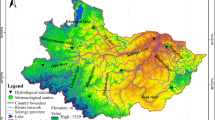Abstract
This paper established mix regression model for simulating annual flow, in which annual runoff is auto-regression factor, precipitation, air temperature and water consumption are regression factors; we adopted 9 hypothesis climate change schemes to forecast the change of annual flow of Sanmenxia Station. The results show: (1) When temperature is steady, the average annual runoff will increase by 8.3% if precipitation increases by 10%; when precipitation decreases by 10%, the average annual runoff will decrease by 8.2%; when precipitation is steady, the average annual runoff will decrease by 2.4% if temperature increases 1°C; if temperature decreases 1°C, runoff will increase by 1.2%. The mix regression model can well simulate annual runoff. (2) As to 9 different temperature and precipitation scenarios, scenario 9 is the most adverse to the runoff of Sanmenxia Station of Yellow River; i.e. temperature increases 1°C and precipitation decreases by 10%. Under this condition, the simulated average annual runoff decreases by 10.8%. On the contrary, scenario 1 is the best to the enhancement of runoff; i.e. when temperature decreases 1°C precipitation will increase by 10%, which will make the annual runoff of Sanmenxia increase by 10.6%.
Similar content being viewed by others
References
Chow, V. T., Maidment, D. R., Mays, L. W., Applied Hydrology, New York: McGraw-Hill, 1988.
Gleick, P., Global climatic changes: a summary of regional hydrological impacts, Civ. Engng. Pract., 1990, 5(1): 53–68.
Nash, L. L., Gleick, P. H., Sensitivity of streamflow in the Colorado Basin to climatic changes, J. Hydrol, 1991, 125: 221–241.
Thompson, S. A., Simmulation of climate change impacts on water balances in the central United States, Phys. Geogr., 1992, 13(1): 31–52.
Henratty, M. P., Stefan, H. G., Simulating climate change effects in a Minnesota agricultural watershed, J. Environ. Qual., 1998, 27: 1524–1532.
Freeze, R. A., A stochastic-conceptual analysis of rainfall runoff processes on a hillslope, Water Resource Res., 1980, 16(2): 391–408.
Andel, J., Non-negative autoregressive process, Time Series Analysis, 1989, 10: 723–731.
Bell, C. B., Smith, E. P., Inference for non-negative autoregressive schemes, Communication in Statistics-Theory Method, 1993, 15(b): 1103–1113.
Yang Wei-xing, Gu Lan, Time Series Analysis and Dynamic Data Modeling (in Chinese), Beijing: Beijing Industry College Press, 1986.
Wu Ya-qing, Li Zhen-zui, Application of hydrological forecast with multidimensional and hybrid regression system, Sichuan Hydropower (in Chinese), 2000, 19(2): 14–17.
Wang Guo-qing, Wang Yuan-zhang, Climate change effect on the water volume in the upper-middle reaches of Yellow River, People’s Yellow River (in Chinese), 1994, 16(4): 53–59.
Ding Jing, Liu Quan-chon, Stochastic Hydrology (in Chinese), Beijing: China Water Conservancy and Hydropower Press, 1997, 71–92.
Author information
Authors and Affiliations
Corresponding author
Rights and permissions
About this article
Cite this article
Jiang, X., Liu, C., Wang, Y. et al. The study on Sanmenxia annual flow forecasting in the Yellow River with mix regression model. Sci. China Ser. E-Technol. Sci. 47 (Suppl 1), 118–126 (2004). https://doi.org/10.1360/04ez0010
Received:
Issue Date:
DOI: https://doi.org/10.1360/04ez0010




